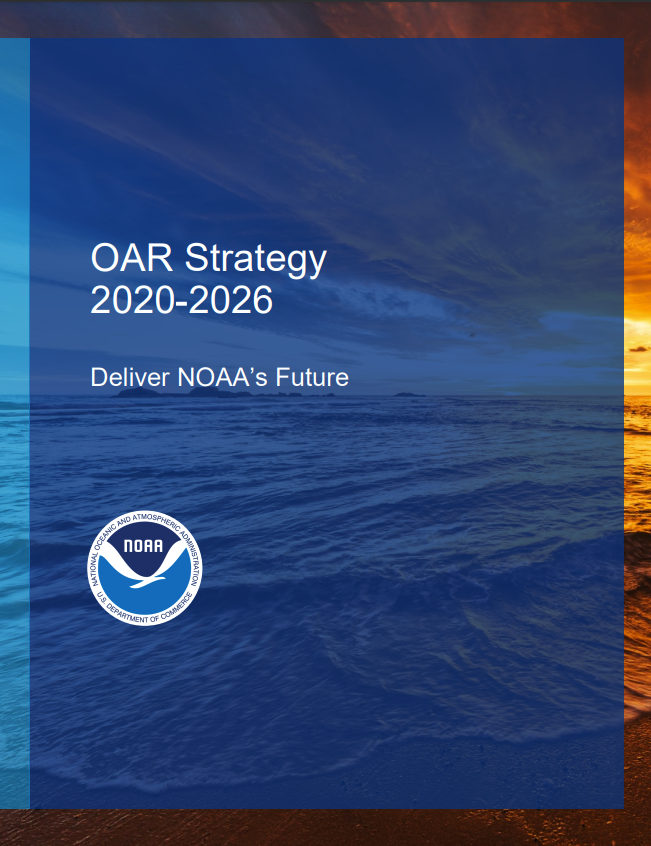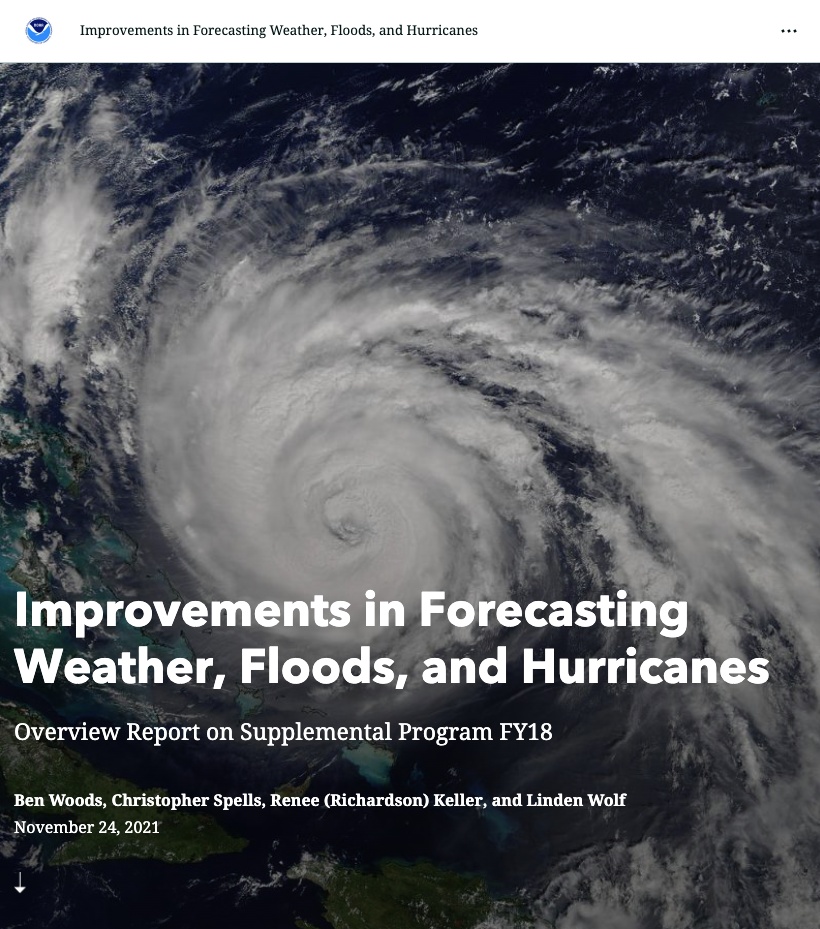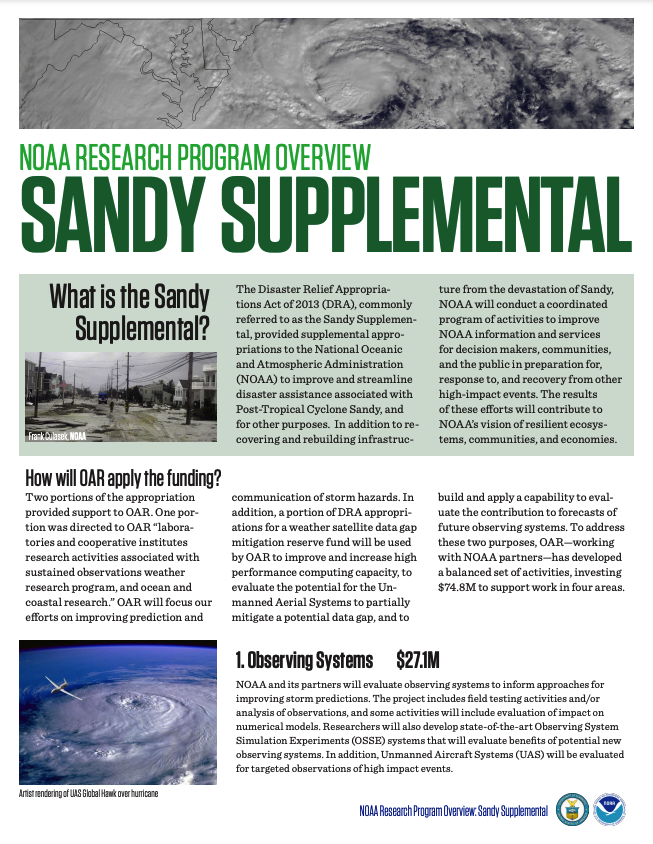NOAA Research Budget
Supporting NOAA’s climate, ocean, and weather products and services.
NOAA Research budget and strategy direct the research priorities to understand and predict the Earth system; develop technology to improve NOAA science, service, and stewardship; and transition the results so they are useful to society. Learn more about the current appropriations and OAR’s strategic approach to deliver world-class science for the fulfillment of NOAA’s mission.
For more information, visit NOAA Budget and Legislative Information & White House Briefing Room.
Please direct any questions to our office.
FY 2025 President’s Budget Request
The Biden Administration has released the President’s FY 2025 Discretionary Request.
$645.729 Million (FY24 President’s Budget for OAR)
Decrease from FY24 enacted
FY 25 Discretionary Request includes a total of $645.729M for OAR, a net decrease of $142.5M from the FY 2023 enacted levels/FY 2024 Annualized Continuing Resolution.
For details on OAR, see the NOAA’s Fiscal Year 2025 Budget Summary (Blue Book) [PDF; OAR begins on p.28], the Congressional Justification [PDF; OAR’s executive summary begins on p.445] or the NOAA Budget Office page.
The FY 2025 Budget continues to support investments in the Inflation Reduction Act (IRA) and Bipartisan Infrastructure Law (BIL) for Climate-Ready Coasts, climate data and services, and fisheries and protected resources.
Budget by Fiscal Year
CONSOLIDATED APPROPRIATIONS ACT OF 2024
Sustaining Critical Operations & Research
On March 9, 2024, President Biden signed the Consolidated Appropriations Act, 2024 (Pub. L. 118-42) into law. This provides a total of $6.72B for NOAA. This includes $4.55B for NOAA Operations, Research and Facilities (ORF) and $1.72B in Procurement, Acquisition and Construction (PAC).
OAR received $675.3M in ORF funds, a decrease of $6.9M below FY 2023 enacted. This includes $19.2M in Community Project Funding.
OAR Climate Research is funded at $224.1M, which is equal to FY 2023 enacted.
- Climate Laboratories and Cooperative Institutes: $104.1M (equal to FY 2023 enacted)
- Regional Climate Data and Information: $47.9M (equal toFY 2023 enacted)
- Climate Competitive Research: $72.1M (equal to FY 2023 the enacted)
OAR Weather and Air Chemistry Research is funded at $162.2M, which is a decrease of $4.2M below FY 2023 enacted.
- Weather Laboratories and Cooperative Institutes: $90.2M ($3.0M decrease below FY 2023 enacted)
- U.S. Weather Research Program: $39.1M (equal to FY 2023 enacted)
- Tornado Severe Storm Research/Phased Array Radar: $20.9M (equal to FY 2023 enacted)
- Joint Technology Transfer Initiative: $12.0M ($1.2M decrease below FY 2023 enacted)
Ocean, Coastal and Great Lakes Research is funded at $251.5M, which is equal to FY 2023 enacted.
- Ocean Laboratories and Cooperative Institutes: $39.5M (equal to FY 2023 enacted)
- National Sea Grant College Program: $80.0M (equal to FY 2023 enacted)
- Sea Grant Aquaculture Research: $14.0M (equal to FY 2023 enacted)
- Ocean Exploration and Research: $46.0M (equal toFY 2023 enacted)
- Integrated Ocean Acidification: $17.0M (equal to FY 2023 enacted)
- Sustained Ocean Observations and Monitoring: $52.5M (equal to FY 2023 enacted)
- National Oceanographic Partnership Program: $2.5M (equal to FY 2023 enacted)
Innovative Research and Technology is funded at $18.2M, which is a decrease of $1.0M below FY 2023 enacted.
- High Performance Computing Initiatives: $18.2M (equal to FY 2023 enacted)
- Uncrewed Systems: $0.0M ($1.0M decrease below FY 2023 enacted, terminated in FY24)
OAR received $70.0M in PAC funding, a decrease of $30.0M below FY 2023 enacted.
Systems Acquisitions is funded at $70.0M, which is a decrease of $30.0M below FY 2023 enacted.
- Research Supercomputing/CCRI: $50.0M ($20.0M decrease below FY 2023 enacted)
- Research Acquisitions and Management (RAM): $20.0M ($10M belowFY 2023 enacted)
CONSOLIDATED APPROPRIATIONS ACT OF 2023
Prioritizing Critical Operations & Research
On December 29, 2022, President Biden signed the Consolidated Appropriations Act, 2023 (Pub. L. 117-328) into law. This provides a total of $6.35B for NOAA. This includes $4.54B for NOAA Operations, Research and Facilities (ORF) and $1.76B in Procurement, Acquisition and Construction (PAC).
OAR received $682.1M in ORF funds, an increase of $63.6M above FY 2022 enacted. This includes $20.8M in Community Project Funding.
OAR Climate Research is funded at $224.1M, which is an increase of $24.1 above FY 2022 enacted.
- Climate Laboratories and Cooperative Institutes: $104.1M ($15.1M increase above FY 2022 enacted)
- Regional Climate Data and Information: $47.9M ($2.9M increase above FY 2022 enacted)
- Climate Competitive Research: $72.1M ($6.1M increase above FY 2022 the enacted)
OAR Weather and Air Chemistry Research is funded at $166.4M, which is an increase of $22.0M above FY 2022 enacted.
- Weather Laboratories and Cooperative Institutes: $93.2M ($5.5M increase above FY 2022 enacted)
- U.S. Weather Research Program: $39.1M ($12.3M increase above FY 2022 enacted)
- Tornado Severe Storm Research/Phased Array Radar: $20.9M ($3.9M increase above FY 2022 enacted)
- Joint Technology Transfer Initiative: $13.2M ($0.2M increase above FY 2022 enacted)
Ocean, Coastal and Great Lakes Research is funded at $251.5M, which is an increase of $14.5M above FY 2022 enacted.
- Ocean Laboratories and Cooperative Institutes: $39.5M ($2.4M increase above FY 2022 enacted)
- National Sea Grant College Program: $80.0M ($4.0M increase above FY 2022 enacted)
- Sea Grant Aquaculture Research: $14.0M ($0.5M increase above FY 2022 enacted)
- Ocean Exploration and Research: $46.0M ($2.6M increase above FY 2022 enacted)
- Integrated Ocean Acidification: $17.0M ($1.0M increase above FY 2022 enacted)
- Sustained Ocean Observations and Monitoring: $52.5M ($3.5M increase above FY 2022 enacted)
- National Oceanographic Partnership Program: $2.5M ($500K increase above FY 2022 enacted)
Innovative Research and Technology is funded at $19.2M, which is an increase of $1.2M above FY 2022 enacted.
- High Performance Computing Initiatives: $18.2M ($0.2M increase above FY 2022 enacted)
- Uncrewed Systems: $1.0M as a new initiative ($1.0M increase above FY 2022 enacted)
OAR received $100M in PAC funding, an increase of $51.5M above FY 2022 enacted.
Systems Acquisitions is funded at $100.0M, which is an increase of $51.5M above FY 2022 enacted.
- Research Supercomputing/CCRI: $70.0M ($21.5M increase above FY 2022 enacted)
- Research Acquisitions and Management (RAM): $30.0M as a new initiative for a demonstration system for dual polarization Phased Array Radar (PAR) ($30M increase above FY 2022 enacted)
CONSOLIDATED APPROPRIATIONS ACT OF 2022
Prioritizing Critical Operations & Research
On March 15, 2022, the Consolidated Appropriations Act, 2022 (Pub. L. 117-103) was signed into law by President Biden. This provides a total of $6.1B for NOAA. This includes $4.42 billion for NOAA Operations, Research and Facilities (ORF) and $1.69 billion in Procurement, Acquisition and Construction (PAC).
OAR received $599.4 million in ORF funds, an increase of $28.9 million from FY 2021.
OAR Climate Research is funded at $200.0M, which is a $18.0M increase from FY 2021 enacted.
- Climate Research Labs and Cooperative Institutes: $89.0M ($13.0M increase above the FY 2021 enacted)
- Regional Climate Data and Information: $45.0M ($2.5M increase above the FY 2021 enacted)
- Climate Competitive Research: $66.0M ($2.0M increase above the FY 2021 enacted)
OAR Weather and Air Chemistry Research is funded at $144.4M, which is a $5.0M increase from FY 2021 enacted.
- Weather and Air Chemistry Research Labs and Cooperative Institutes: $87.7M ($2.2M increase from the FY 2021 enacted and at the President’s Budget Request level)
- U.S. Weather Research Program: $26.8M (increase of $263K from FY 2021 enacted.
Ocean, Coastal and Great Lakes Research is funded at $237.0M, which is an increase of $5.6M above the FY 2021 enacted.
- Ocean, Coastal and Great Lakes Research Labs and Cooperative Institutes: $37.1M (increase of $610K from the FY 2021 enacted)
- National Sea Grant College Program base: $76.0M (a $1.0M increase above the FY 2021 enacted)
- Marine Aquaculture: $13.5M (an increase of $500K from the FY 2021 enacted and $376K above the President’s Budget Request)
- Ocean Exploration and Research: $43.4M ($400K increase above the FY 2021 enacted and equal to the President’s Budget Request)
- Integrated Ocean Acidification: $16.0M (an increase of $500K above the FY 2021 enacted and $302K above the President’s Budget Request)
- Sustained Ocean Observations and Monitoring: $49.0M (increase of $3.6M from the FY 2021 enacted, but $17.8M below the President’s Budget Request)
- National Oceanographic Partnership Program: $2.0M (a decrease of $1.0M from the FY 2021 enacted)
Innovative Research and Technology is funded at $18.0M, which is $200Kabove FY 2021 enacted and $4.0M below the President’s Budget Request.
- High Performance Computing (HPC) Initiatives ORF – HPC ORF is funded at $18.0MM, ( an increase of $200K above the FY 2021 enacted).
OAR received $48.5M in PAC funds, an increase of $5M from FY 2021 enacted.
- Research Supercomputing: Research supercomputing PAC is funded at $48.5M, which is a $5.0M increase above the FY 2021 enacted.
NOAA Research Strategy
NOAA Research has been on a journey to transform in order to be successful in the future, to effectively deliver NOAA’s future and be competitive in the environmental R&D market.
To that end, NOAA Research has developed the 2020-2026 OAR Strategy to help further OAR as a leader in environmental research and assist us in meeting our vision to deliver NOAA’s future.
The research landscape of tomorrow will be different from that of today. There will likely be additional contributors to the sciences OAR studies, including more involvement from the private sector, increased philanthropic participation, and greater academic integration. There will always be a unique role for long-term research exclusively dedicated to NOAA’s diverse missions, and that remains OAR’s sole job.
Four Goals to Deliver NOAA’s Future
Our goals reflect what OAR desires to achieve, where to focus activities, and ultimately, how to improve OAR’s ability to deliver NOAA’s future.
Explore the Marine Environment
Detect Changes in the
Ocean & Atmosphere
Make Forecasts Better
Drive Innovative Science
The 2020-2026 OAR Strategy creates a framework aligned with the NOAA Research and Development Vision Areas: 2020-2026.
Each of our laboratories and programs are guided by their own strategies that you can view by visiting their websites.
Download the OAR Strategy.
Please direct questions on the OAR Strategy to our office.
Please see NOAA Science Council for information on additional NOAA research policies and plans. Below are examples of some relevant strategies and documents guiding our research.
- NOAA Scientific Integrity Policy
- NOAA Blue Economy Strategy
- Ocean Climate Action Plan
- NOAA Carbon Dioxide Removal (CDR) Science Strategy
- National Strategy for Mapping, Exploring, and Characterizing the United States Exclusive Economic Zone
- National Ocean Acidification Action Plan
- Equitable Climate Services Action Plan



